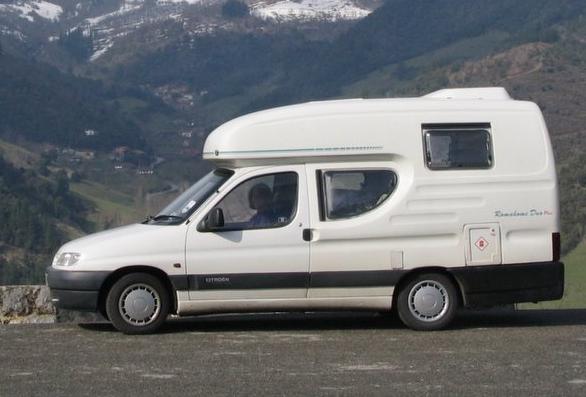We decided not to move on this morning but to spend the day sorting out a whole mass of emails, the blogsite and niggling problems with our home insurance. However carefully plans are laid, insurance companies will find a way of losing papers or failing to activate direct debits. Freephone services are of no use from Spain and the website of our company is impossibly vague about contact details so most of the morning was wasted trying to rectify the mess they have made for us.
Afterwards we strolled in the massive weekly market held on the seafront. The Spanish seem to have a love affair with fleecy-lined slippers to judge by the number of stalls devoted to them. As most buildings appear to be marble tiled, lacking in rugs and carpets and are generally unheated, slippers and bootees may well be necessary to survive the rigours of winter. Certainly we have found the inside of many buildings very cold here. Much of our experience has been on Spanish campsites of course where not only is heating absent and stone tiling abundant, there is also a marked absence of doors! Gaping holes in the sides of shower blocks and toilets are probably fine in summer, but singularly unpleasant on winter nights and mornings.
In the centre of Blanes we found the theatre café and stopped for a pleasant lunch and coffee. Here we tried to work out the news from the local paper, provided free in most bars and cafés. The advantage of not speaking the language is that we can cope as well – or badly - with Catalan as Spanish. The ideal is parallel text as frequently if we cannot work out a word in one language, it is possible to do so in the other.
By this time it was too late to move on so we took a brisk stroll along the seafront and walked out across the rocks to a small island just off shore. Here we watched birds fishing from the rocks until the cold wind forced us to return to the esplanade.
 The entrance to Blanes harbour from the rocks offshore
The entrance to Blanes harbour from the rocks offshore Blanes seafront and birds fishing from the rocks offshore
Blanes seafront and birds fishing from the rocks offshoreThe evening found us at the internet café again still sorting out emails. The young man running the place was eager to practice his English on us – and we were delighted not to have to use our pigeon Spanish. He told us he was from Bolivia and found Catalan really difficult to cope with. He was most helpful to us and when we left he gave us our change with a big smile and a “chers mai – is good no?” Not having the heart to dampen his enthusiasm by explaining that you didn’t usually address people almost old enough to be your grandparents by such a term, we corrected his pronunciation and left him muttering to himself “cheers mate, cheers mate.” The end of a pleasant and restful day in a very nice little town.
Tuesday 24th January 2006, Vinaròs, Costa del Azahar
Travelling can be a very wearying business and today has been possibly one of the most difficult and tiring days we have had to contend with so far.
By 9.30 this morning we were on our way, leaving Blanes behind in the sunshine, heading for Barcelona on the motorway. Normally we try to avoid using motorways but in the interests of circumnavigating Barcelona we decided to take what we thought would be the easy option. However, the best laid plans can go awry and somehow we managed to get into the wrong lane a couple of times, causing untold frustrations that ended us up in the very heart of the city. This was not too bad as traffic moves in a very civilised way within the city, but out on the motorways, you really do need to know where you are heading and the names of every town in between and beyond as road signing seems very inconsistent. Into the bargain, several roads and exits had been renumbered since the “new edition” map we bought last week was published! We did eventually reach Tarragona, but by the wrong route taking us miles inland instead of along the coast. As if all that had not been stressful enough, the campsite listed in our book as open turned out to be closed with nowhere else available locally. Leaving Modestine fully laden in side roads overnight is worrying so we were not keen to seek out an hotel in the town – though almost everywhere seemed shut anyway – so we continued to the next site on our list, some miles further along the coast at a boring seaside place that had nothing of interest for us and was too far for us to use as a base to return to Tarragona with its outstanding Roman remains. In any case, the site was unpleasantly smart and charged 25 euros a night (Blanes had been 12 and perfectly adequate.)
With a couple of hours until darkness, we decided to continue to Vinaròs, a seaside town with a pleasant enough beach but rather run-down and too much graffiti along the seafront where the walls are spray-painted, frequently very artistically, but out of place and unpleasant. Nowhere could we find the campsite listed in our guidebook and darkness was falling fast. Eventually we chanced on the seafront tourist information centre who informed us the site no longer existed but mercifully directed us to a different one which is back inland from the sea but quite pleasant and extremely crowded. (15 euros). There really is a strong demand for sites to be open all year and it is a pity that when they are, they are invariably located near beaches rather than cities or cultural sites. It’s also rather worrying that our campsite book is so inaccurate for Spain when we had found it so good in France.
The climate here is said to be particularly mild as the town is protected by the range of arid mountains behind. We arrived from the far side of this range and noted that the landscape here is definitely more dry, sandy and arid than further east. The valley behind the mountain range was completely covered in olive trees for mile after mile. As we turned off towards the sea we passed huge orchards of orange trees bearing their glowing fruits - the area is known as the orange-blossom coast – though no sign of any blossom yet.
The only positive thing that has come out of a very frustrating day, is that we have absolutely no pictures to edit this evening and can have an early night as we are both exhausted. Tomorrow we face yet more frustrations as we try to find a way to bypass Valencia and find a campsite open nearby with transport links into the city.
Thursday 26th January 2006, Cullera, south of Valencia
Some days are just awful and yesterday was one. It started okay. We were delayed leaving our campsite by its resident parrot which insisted on giving us a lesson in Spanish pronunciation, repeatedly replying to our “hello” with “hola”. Amused by this, we made our way happily along the national route towards Valencia, travelling through a landscape of bare, grey, rugged hills sparsely covered in dark green scrub. Frequently the roadsides were lined by orange or olive groves. Beneath the former the fallen fruit lay rotting, literally an orange carpet beneath the trees, while in the latter, men were beating the trees to bring down the olives. Idyllic as this sounds, we must honestly confess that the towns in between were the epitome of ugliness, with graffiti scrawled absolutely everywhere and rubbish dumped in ditches along the roadsides on the outskirts of the towns. This is perhaps what the average package tour visitor does not see and certainly is never shown or mentioned in guidebooks. However, it is the ugly side of Spain, and we anticipate it will get worse as we travel south.
Suddenly, almost before we were aware of it, the comfortable, straight roads started to converge and we found ourselves on a four-lane highway pouring into Valencia. The map suddenly became a work of fiction and we had no option but to go with the flow, trying frantically to work out where we were and find our route south of the town. How we survived without an accident we will never know. NEVER does Jill intend to face such a driving ordeal again! Rarely has she been so terrified! Fortunately there were frequent traffic lights at which to take stock and realise we didn’t have the foggiest idea where we were – other than in Spain’s third largest city with a population of 777,427 (give or take a couple)
Huge lorries ploughed their way through the city centre, crossing happily between the four lanes at every roundabout, while we became more and more scared and lost. Eventually we found somewhere to pull to the side, simply to stop and take stock. It was then that we realised the loud bang a few moments earlier was the sound of one of Modestine’s brand new tyres exploding! We leave you to imagine how we felt, suffice to say it was the nadir of our travels!
Once we had recovered our nerve and convinced ourselves we were lucky it was not worse – it could have been out on the desert roads we’d travelled through and it could have been August heat, in the middle of a roundabout, etc. we abandoned Modestine and set off in search of -
A) a loo – found at a nearby swimming pool where in sheer desperation we gate-crashed the changing rooms. Jill can only speak for herself but she found the room filled with naked Spanish ladies speaking volubly together and giving her curious stares (Ian ditto but men not talking so volubly).
B) A phone box to contact our insurance company in Manchester to ask for international assistance – Modestine’s biggest failure is the position in which her spare wheel is stored, completely inaccessibly between her back wheels. The company were excellent, calming us down and assuring us of help. Two hours later we rang them back to say nothing had happened. This time we were obliged to wait in a queued system listening to piped music and soothing recorded messages telling us that our call was important to the company and would be answered as soon as possible! And this on their emergency international helpline number! When we finally made contact they said we’d given them the wrong information! We are retired librarians! We don’t give wrong information! The Spanish do though! The road name at the end of the street is not the same as the one on the city’s street plan! We hadn’t got a map of Valencia so didn’t know this! After more than three hours waiting in the centre of a huge city, with traffic roaring by, feeling sick with worry and hunger, rescue arrived in the form of a non-English speaking emergency rescue service. Soon he had the tyre changed and, discovering Ian knew more Spanish than he realised, we managed to ask instructions for finding the nearest Citroën garage so we could get the tyre pressure checked and a replacement tyre. Hoping we’d understood about crossing the bridge and turning second off at the roundabout with the blue tower etc. etc. we set off into the chaos again. “Toot toot” we were overtaken on the inside by our road-rescue driver, gesticulating to follow him. This we did, frantically jumping lights and weaving, like him, from lane to lane as we spun through the vortex of Valencian traffic. At a set of traffic lights our leader climbed down, gave us a tirade of Spanish from which between us we worked out where we had to go, and he then drove off in a different direction.
At the Citroën garage nobody spoke any English – indeed, why should they? But we were so tired, worried, hungry and thirsty we really longed to be able to explain our problem without having to cope in Spanish. They were delightfully helpful and tested our tyre saying it looked like a knife cut on the wall of the tyre rather than anything actually puncturing the tread. We still have no idea how the damage occurred but will just have to write off the cost even though the tyres are only three weeks old and under guarantee. Needless to say, they did not stock a replacement tyre and after phoning every Citroën dealer in Valencia they said it would take two days to find a replacement!
So that was a waste of time and we still had to find our way out of the city centre and somewhere to sleep for the night. Out in the traffic again we were immediately lost, ending up in a transport depot. Here a delightful Spanish man asked where we wanted to get to and jumped into his car, indicating to follow him. He drove around a whole network of back roads, with Modestine glued to his tail, until we ended up on the motorway, when he indicated the route we should take and disappeared off an exit road waving as he went! Brilliant international communication and so very friendly! Soon we found the turn-off to the little village on the edge of the vast Albufera, or fresh-water lagoon we had been seeking. Here came our next disaster when we discovered that the campsite, listed as open, no longer existed! With two bikes and a filthy punctures wheel in the back of Modestine sleeping by the roadside was not an option but any hotels we found were shut. Eventually we chanced upon an open campsite and were forced to pay an exorbitant 23 euros for facilities that were filthy, the water turned off and the toilets stinking. Into the bargain, the electricity didn’t work. We’d eaten and drunk nothing since breakfast and felt life couldn’t go any lower. However, when you think you are in the basement, you sometimes discover there is actually an even lower level you knew nothing about. Next to us an Englishman appeared, happy to find fellow countrymen and to be helpful. He had a large and vociferous dog and insisted on helping us to settle, knocking on our door with bottles of water and telling us he didn’t mind the conditions on the site as he’d fought in Africa and was just happy to have got out alive. He owned several houses in Blackpool so didn’t mind paying extortionate prices etc.etc. He meant well, but we didn’t need that on top of our worries!
So we ended up going to bed hungry, unwashed, feeling sick using the loo which didn’t flush and only after Ian had discovered enough Spanish to shout at the campsite owner did we get any electricity or water.
Ian was amazing! (Jill writing). He found so much graffiti on the toilet walls he was able to construct from it an entire, possibly obscene, tirade to the campsite owners about shit in the toilet bowls as well as no lighting, water or electricity etc. He demanded improvements. First thing this morning people appeared, emptied overflowing rubbish containers, turned on lighting and water, and even cleaned all the loos which really did stink! Of course there was still no hot water but we were glad to see the back of the site.
We slept badly and left the campsite with relief this morning. Jill’s nerve failed for returning to Valencia to try to get Modestine’s wheel fixed so we drove along the road separating the sea from the lagoon behind. This is Spain’s largest lake and is really their answer to the Camargue. Here there were thousands of white egrets feeding in the muddy shallows. There were water fowl, herons and cormorants. As in the Camargue, rice is grown and has been since the 13th century. Our route was lined by pine trees, neat market gardens and orange groves and passed through several attractive little villages until we turned off at Cullera, still searching for a Michelin tyre place. We found one on the edge of the town. Needless to say they did not have our commercial grade tyres in stock, so we have been obliged to stay until tomorrow morning when they will sort us out. All this in Spanish! Ian is really brilliant! Of course there are no all year campsites near here and Jill doesn’t like driving around without a spare wheel, so we parked on the seafront of this resort, which has proved to be far bigger and more interesting than we ever imagined, and set off to explore local hotels. The owner of this one spoke no English but good French so we negotiated a really nice, huge room with sunny balcony for 40 euros, including breakfast. Compared with 23 euros for last night’s campsite it is an unbelievable bargain! Time to treat ourselves! We’ve pummelled our laundry in the bath and sat in the sunshine drinking wine as our undies dry on the balcony. During the day we have explored the town, looked around the weekly market, enjoyed coffee and croissants in a pleasant bar, and climbed up the Calvary with the 14 stations of the Cross, which had existed since the 13th century, to the 19th century sanctuary high on the bare hillside above the steeply stepped streets of the old town.
 Roofscape of Cullera from the sanctuary above the town
Roofscape of Cullera from the sanctuary above the town The route up to the sanctuary above the town, Cullera
The route up to the sanctuary above the town, Cullera One of the stations of the cross on the route up to the sanctuary, Cullera
One of the stations of the cross on the route up to the sanctuary, Cullera The sanctuary above Cullera
The sanctuary above Cullera Tiled plaque commemorating the efforts of the citizens to construct the Calvary and sanctuary, Cullera
Tiled plaque commemorating the efforts of the citizens to construct the Calvary and sanctuary, CulleraFrom here we followed a stony, deserted track out onto the barren, grey, scrubby hills above the town with vistas down onto the market gardens, orchards and vast expanses of paddy fields on one side, and the empty sandy beaches with their palm trees, the azure sweep of the sea and the seaside apartments lining the shore on the other. Up here we watched an eagle soaring, high above the hillside, before making our way down through the empty garrigue (same word as in French but pronounced differently) to the town and seafront for a sunset stroll before returning to our wonderfully spacious and luxurious hotel. At least it seems so to us after so long cramped in dear old Modestine who would fit into our bathroom here with room for a friend as well! Time now to find somewhere for supper in the town and an hour on one of the coin-in-the slot internet access points to read our email.
 View towards the coast from the sanctuary with the river Zúquer, Cullera
View towards the coast from the sanctuary with the river Zúquer, Cullera Market gardens beside the river Zúquer, Cullera
Market gardens beside the river Zúquer, Cullera High rise holiday accommodation along the sea front
High rise holiday accommodation along the sea front Remains of an old fort high in the hills above Cullera
Remains of an old fort high in the hills above Cullera The narrow strip of land between the sea and the Albufera with waterlogged rice fields, Cullera
The narrow strip of land between the sea and the Albufera with waterlogged rice fields, Cullera The beach from the esplanade
The beach from the esplanade The esplanade from the beach
The esplanade from the beachFriday 27th January 2006, Vera, Costa de Almeria
Hold on to your hats folks, and place them where they can be put to best use. For us this evening that is not on our heads. We find ourselves staying on a naturist campsite that is open all year! The south of Spain it may be but it’s rather chilly on this wet January evening! Our guidebook to campsites let us down again. The only site listed along this part of the coast was closed and up for sale. So we drove along the winding clifftop road searching in vain for somewhere to spend the night. Eventually seeing this site as dusk fell we drove in with a sense of relief only to be told at reception that it wasn’t quite what we expected! “Can we keep our clothes on please as it’s a bit chilly” asked Ian in his best Spanish! We were told that this would be okay so long as we didn’t mind sharing unisex showers. So yet another novel experience for us retired crumblies!
Last night we discovered the down-side of Spanish hotels. Ours was incredibly noisy with people shouting in the corridor, slamming doors and running up and down. This went on until well after midnight when Ian, who is becoming very bolshie, shouted “Buenas noches” to everyone far more loudly than any of their noise! There was immediate silence for the rest of the night.
This morning it started to rain as we were having breakfast. We desayuno what Spanish breakfasts are like – orange juice, sticky doughnutty thing, roll and jam and rather strong coffee. All in all, the hotel was a very enjoyable experience and just what we needed to calm us down.
Our tyre was waiting for us at the garage and in no time Modestine was sorted and ready to go. Our plan had been to move on to a campsite further down the coast and leave Modestine so we could take the train back into Valencia for the day. However, the railway station and campsite were miles apart and it was a dismal campsite with poor facilities. As it was teaming with rain it wouldn’t have been enjoyable wandering the streets of Valencia anyway.
So we set off south, transferring to the motorway after we realised just how long it would take passing through the snarled-up traffic of every town on the national roads. This area of Spain really does not have pretty countryside. Most of the towns we have seen are hideously ugly and although our route has frequently been through endless acres of citrus orchards with their bright yellow and orange fruits, or magnificent date palms, their beauty is marred by ugly cement works, quarries, factories, hoardings and half-built structures invariably covered in garish and obscene graffiti.
Much of the landscape is a bare rocky desert of red and yellow rock with nothing but a few sparse cactuses to break the monotony. The mountains to either side of the motorway today were just misty outlines through the rain and spray of passing lorries. Where river valleys had left flat fertile plains, market gardens flourished with huge expanses of green vegetables. Beyond Alicante these gave way to endless plastic greenhouses covering huge patches of hillsides and plains. At least it was using the arid landscape productively and has to be accepted, but it is not a pleasant sight.
Why, we have asked ourselves so many times, do the Brits want to forsake a green and beautiful place like Britain, with its diversity of climate and landscape, to live on the edge of a barren desert in southern Spain where so many of the towns we have passed through are the ugliest we have ever seen. Always, we are told, the climate is wonderful here while in Britain it rains. Yes, and that’s why Britain is green and beautiful. We’ve had damp, clammy fog and rain all day here anyway, and in summer it would be ugly, dusty and searingly hot.
We passed Benidorm on the motorway from where we glimpsed a forest of high-rise apartment blocks. What tortuous sense of enjoyment crams everyone together like this and what on earth is there to do except sit around in bars with a cold beer? We had to come to observe this, but will probably not choose to come again. Give us the Moorish splendour of Spain’s wonderful cities – Granada, Cordoba and Seville - rather than its coastal tourist strip any day. That said, we have to admit that the coast and the sea are lovely, with azure sea, green palms and golden sand, especially when we have them to ourselves at this time of year.
We turned off the motorway down to the coast at Aguilas and were delighted to discover a black schist landscape that reminded us greatly of the north Cornish coast. There even seemed to be mining chimneys amidst the green scrub and wonderful vistas of the Mediterranean breaking gently over offshore rocks. No plastic covering the landscape here. For miles we climbed and dipped along the deserted coast road with just the occasional isolated villa in Moorish style - very unlike SW England - on a rocky promontory above the waves.
And so we found this nudist beach and campsite. We’ve finished supper and the rain has eased slightly so we’re just off wash our dishes and to see what other campers wear to keep their tummies dry when they scrape out their pots and pans.
Saturday 28th January 2006, Almerimar, Costa de Almeria
We both slept badly, probably resulting from the ceaseless thumping of heavy rain on Modestine’s roof throughout the night. This morning we found ourselves completely surrounded by water and had to paddle across to the showers. The site is definitely naturist, but with weather as cold and wet as today, campers, almost exclusively German, contented themselves with wandering around in short towelling dressing gowns. No doubt in warmer weather these would be dispensed with.
We fell into conversation with an English couple who have been travelling around Europe for eight years now, having become completely addicted to it. They invited us back to their huge camping car, complete with satellite navigation, a couple of computers, mobile phones and onboard internet and email access, not to mention hot showers, a toilet, freezer and television! They also had a couple of bicycles and a motorbike! We felt very insignificant and amateurish with Modestine, Hinge and Bracket and an old champagne bucket in case of dire emergency! They were very friendly people, helpfully suggesting routes and tried and tested campsites to ensure we got the maximum out of our travels around Spain and Portugal. They even ran us off a CD of their computerised atlas complete with their own annotations which may well prove helpful to us in locating suitable campsites.
The rain poured down in torrents throughout the day. Indeed it has rained continuously for the past 48 hours. We drove cautiously off the site, submerged in its shallow lake of water, around 11am and headed for one of the Spanish Paradors a little further down the coast at Mojàcar. Paradors are top graded state run hotels, frequently located in old castles or buildings of historic interest. This one turned out to be purpose built and modern but luxuriously appointed with lounges and a sun terrace overlooking the sea. Parking Modestine under the palm trees in the grounds we ran through the rain and puddles to seek shelter in the bar with a couple of coffees and to warm up and dry out for half an hour. There is a sense of luxury mixing amongst the resident guests like this as we have discovered at other Paradors and nobody has yet questioned our right to be there.
Here we phoned family and friends in warm comfort, rather than from an exposed phone box on a sodden wet campsite. We also rang friends Jane and Gerry who live in Almerimar on the coast beyond Almeria. They are relatives of our friends Peter and Kate and when we met them for the first time in England last year they rashly suggested we visit them if we pass this way on our travels. They are the warmest and most welcoming of people. When we warned them on the phone this morning that we were heading their way and perhaps we could meet up in a day or two for a drink, they immediately decided that the weather was quite unsuitable for us to camp out on the headland of Cabo de Gata as we had intended and insisted we turn up at their home this evening as they have a spare room and a washing machine! People can be so wonderfully kind and we are delighted and gratified by their hospitality.
We continued along the coast passing through modern town developments of seaside apartments, many still under construction. Drains don’t seem to have been planned for in the towns so the roads were all flooded, with waves and spray being thrown up by passing vehicles while the rain continued to pour down. Gradually the road climbed up from the coast into the hills behind, winding up through the dry, bare rocks where the rainwater just disappeared as soon as it fell. At the top we picnicked in Modestine with a spectacular view down over the dark hillside and rocky cliff tops to the misty sweep of the sea.
 Picnic site, Cabo de Gata National Park
Picnic site, Cabo de Gata National ParkEventually our route took us back inland and we joined the poorly surfaced but mercifully deserted motorway to continue through the rain towards Almeria, passing through spectacularly arid scenery - a landscape of bare rock with hardly a bush anywhere to break the monotony of red and grey mud and rock. So stark is it that it is protected as one of Spain’s national parks and it is used by film companies to create “Paella westerns”. There is even a place known as Mini-Hollywood somewhere in this vast wilderness. We did not venture to explore the area. It looked frighteningly deserted and bleak, particularly in the driving rain with the snow-topped mountains above virtually blotted out by mist.
Around Almería the entire alluvial valley was an endless sheet of white plastic greenhouses where so much of Europe’s early strawberries, tomatoes and courgettes are produced. It’s far from pretty but at least it is using this inhospitable countryside productively.
 A sea of plastic, Almerimar
A sea of plastic, AlmerimarAt Almerimar we had a brief opportunity to see the centre of the town. Everywhere is new, laid out around a large attractive marina with inviting restaurants and bars offering pleasant opportunities to relax when the weather is dryer and warmer. The main commerce here though is real estate. There is an enormous market for property and you are probably more likely to hear English spoken than Spanish. The roads are all attractively landscaped with clean tiled pavements edged with neatly trimmed grass verges with manicured pineapple palms spreading their huge shady fronds as a canopy from summer’s heat.
We received a very warm welcome from Jane and Gerry and we are experiencing once again the sheer pleasure of living in a comfortable home with all modern conveniences! Our hosts are obviously delighted with their lovely new home overlooking the sea and the golf course in one direction and the snow-capped sierra in the other. This is what they retired for, moving out here from Burton on Trent three years ago and having no regrets. With the airport a few miles down the coast at Almería offering cheap flights back to the UK they can probably get back to Birmingham more quickly and cheaply than we can from Exeter! They assure us the quality of life here is infinitely better than in Britain and have high praise for the Spanish health service.
The evening was spent in chatting over mugs of tea and sharing a very copious and delicious Chinese take-away while the rain continued unabated.
Sunday 29th January 2006, Almerimar, Costa de Almeria
This morning we woke to the sound of teaming rain again but over a breakfast of real English toast the skies brightened and the rain cleared. Seizing the opportunity we loaded Jane’s washing machine with all our crumpled bedding from Modestine and we all went off down to the beach and port of Almerimar to enjoy the sunshine before lunch. The town is completely new having developed originally as a marina back in the 1960s but recently greatly expanded. A large proportion of the population is British. English goods are easily obtained here and many of the luxury yachts in the huge marina are registered as British or German. Spain has obviously learned from its mistakes of early tourism. Almerimar is definitely the nicest resort we have so far discovered along this southern coast and is primarily a residential area rather than simply a holiday resort. Our friends here say that they actually accept the surrounding plastic sheeting as it is not readily visible from the town and deters too many tourists from flooding the area in the summer months. In any case, there are plans to gradually remove it and build a health spa instead. Here the buildings are low rise, attractively destined and well laid out amidst beautiful green areas of grass, palm trees, hibiscus, bougainvillea, and cactuses. In summer we are told, the colours of the flowering shrubs are magnificent.
 On the beach, Almerimar
On the beach, Almerimar The harbourmaster’s office, Almerimar
The harbourmaster’s office, AlmerimarWe went for a typical British Sunday lunch at a small café beside the harbour run by a friendly English couple. Accompanied by Spanish wine we enjoyed roast beef with Yorkshire pudding, roast potatoes and fresh vegetables accompanied by bisto gravy and Colman’s horseradish sauce!! It really was a strange experience so far from Britain, but really, after nearly six months abroad there was nothing we could have fancied more.
 Sunday lunch, Almerimar
Sunday lunch, AlmerimarGerry then took us for a drive around the bay. The sea was a wonderful blue and the mountains behind the bare, undeveloped strip of coast west of the town were covered in snow. The sun shone brightly but the air was decidedly chilly despite being just about as far south in mainland Europe as it is possible to be.
 The marina, mountains behind, Almerimar
The marina, mountains behind, AlmerimarOn the barren cliffs here we visited an 18th century Spanish fort now used as a military costume and weapons museum. It was very evocative of Sharpe and his Chosen Men helping the Spanish to fight the French during the Peninsula War.
 The coastal fort of Guardias Viejas near Almerimar
The coastal fort of Guardias Viejas near Almerimar View from the fort to the mountains, Almerimar
View from the fort to the mountains, AlmerimarBack home we relaxed on Jane and Gerry’s sunny terrace watching the sun set over the sea amidst rosy pink clouds.
 View from the terrace, Almerimar
View from the terrace, Almerimar The islands of Les Medes
The islands of Les Medes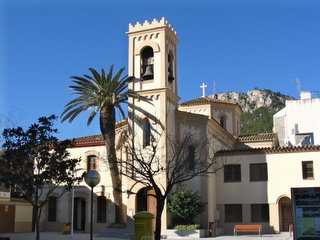 The village church, Estartit
The village church, Estartit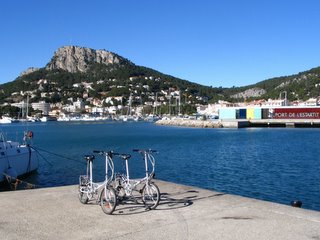 Hinge and Bracket go to the seaside, Estartit
Hinge and Bracket go to the seaside, Estartit On yer bike, Estartit
On yer bike, Estartit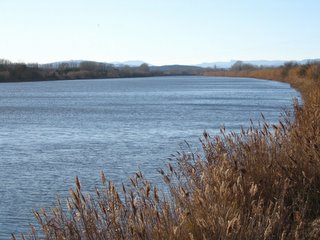 The Ter estuary, Estartit
The Ter estuary, Estartit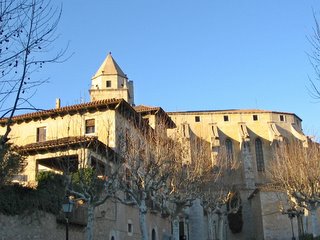 The church and Palau del Mirador, Torroella de Montgrí
The church and Palau del Mirador, Torroella de Montgrí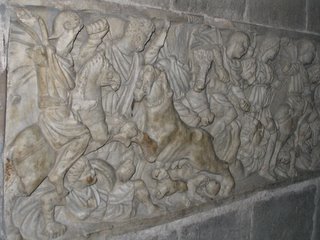 4th century sarcophagus, St. Feliu, Girona
4th century sarcophagus, St. Feliu, Girona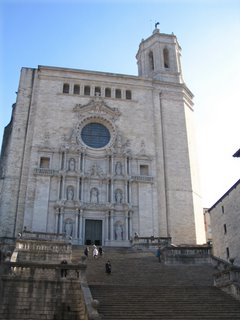 Baroque façade of the cathedral, Girona
Baroque façade of the cathedral, Girona Gothic nave and south door of the cathedral, Girona
Gothic nave and south door of the cathedral, Girona Monument to a mediaeval brainstorming session, Girona
Monument to a mediaeval brainstorming session, Girona Sant Pere de Gallignats, Girona
Sant Pere de Gallignats, Girona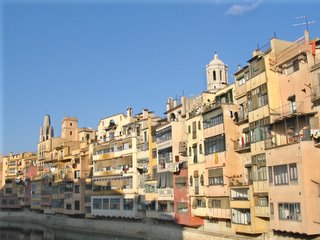 Old houses overhanging the river, Girona
Old houses overhanging the river, Girona Strolling in the Rambla, Barcelona
Strolling in the Rambla, Barcelona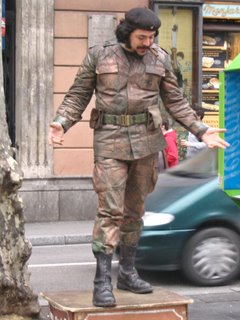 Fidel Casto rejuvenated, Barcelona
Fidel Casto rejuvenated, Barcelona Mercat de la Boqueria, Barcelona
Mercat de la Boqueria, Barcelona Mercat de la Boqueria, Barcelona
Mercat de la Boqueria, Barcelona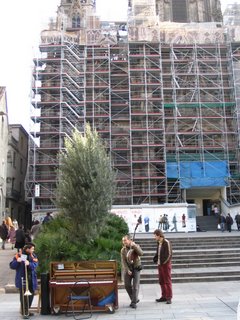 Outside the cathedral, Barcelona
Outside the cathedral, Barcelona Sagrada Familia, Barcelona
Sagrada Familia, Barcelona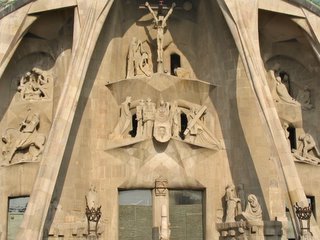 Façade of the Sagrada Familia, Barcelona
Façade of the Sagrada Familia, Barcelona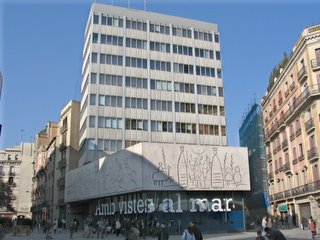 Collegi d’Arquitectes with frieze by Picasso, Barcelona
Collegi d’Arquitectes with frieze by Picasso, Barcelona The packaging better than the contents perhaps, Picasso museum, Barcelona
The packaging better than the contents perhaps, Picasso museum, Barcelona Arc de Triomf, Barcelona
Arc de Triomf, Barcelona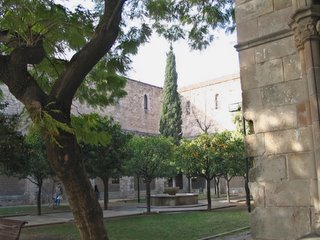 Courtyard with orange trees at the National Library of Catalonia, Barcelona
Courtyard with orange trees at the National Library of Catalonia, Barcelona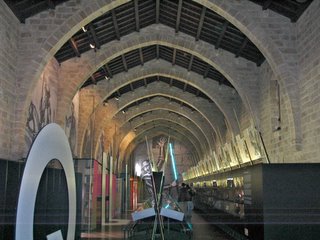 Don Quixote exhibition in the National Library of Catalonia, Barcelona
Don Quixote exhibition in the National Library of Catalonia, Barcelona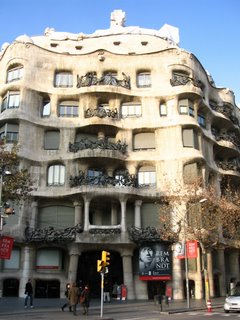 Casa Milà, Barcelona
Casa Milà, Barcelona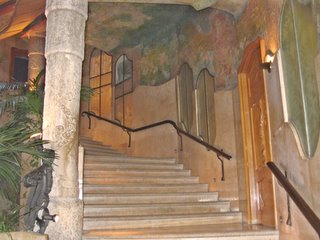 Interior of the Casa Milà, Barcelona
Interior of the Casa Milà, Barcelona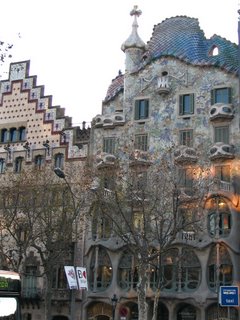 Casa Batlló, Barcelona
Casa Batlló, Barcelona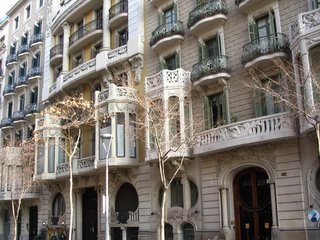 Typical modernist architecture, Barcelona
Typical modernist architecture, Barcelona Building on the Passeig de Gràcia, Barcelona
Building on the Passeig de Gràcia, Barcelona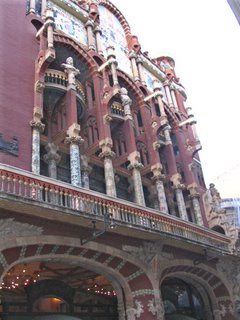 Palau de la Mùsica Catalana, Barcelona
Palau de la Mùsica Catalana, Barcelona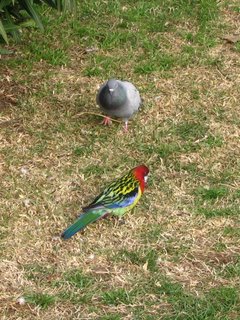 Local birdlife, Blanes
Local birdlife, Blanes View onto the harbour at Blanes
View onto the harbour at Blanes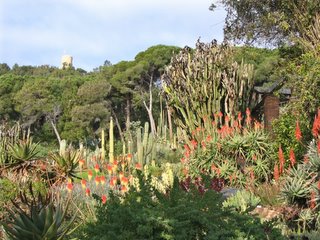 Jardí Botanic Marimurtra, Blanes
Jardí Botanic Marimurtra, Blanes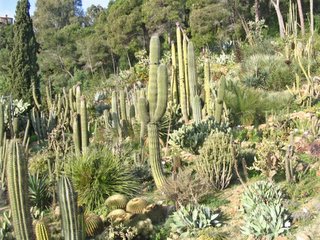 Jardí Botanic Marimurtra, Blanes
Jardí Botanic Marimurtra, Blanes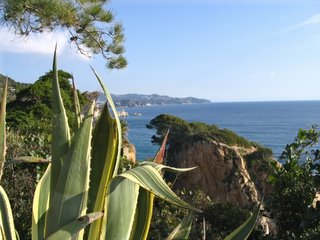 View towards Lloret de Mar from the Jardí Botanic Marimurtra, Blanes
View towards Lloret de Mar from the Jardí Botanic Marimurtra, Blanes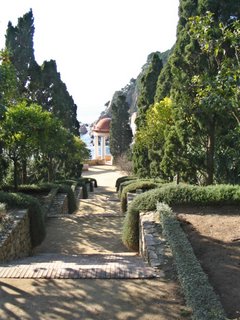 Temple of Linnaeus in the Jardí Botanic Marimurtra, Blanes
Temple of Linnaeus in the Jardí Botanic Marimurtra, Blanes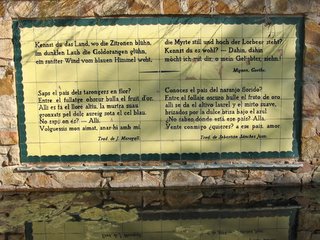 Poem by Goethe translated into Catalan and Castilian in the Jardí Botanic Marimurtra, Blanes
Poem by Goethe translated into Catalan and Castilian in the Jardí Botanic Marimurtra, Blanes View from the Jardí Botanic Marimurtra, Blanes
View from the Jardí Botanic Marimurtra, Blanes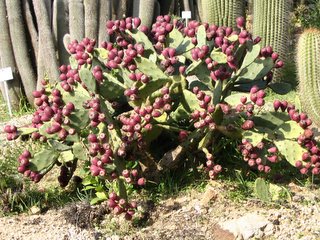 A particularly productive prickly pear, Jardí Botanic Marimurtra, Blanes
A particularly productive prickly pear, Jardí Botanic Marimurtra, Blanes Local people enjoying Sunday lunchtime in Blanes
Local people enjoying Sunday lunchtime in Blanes